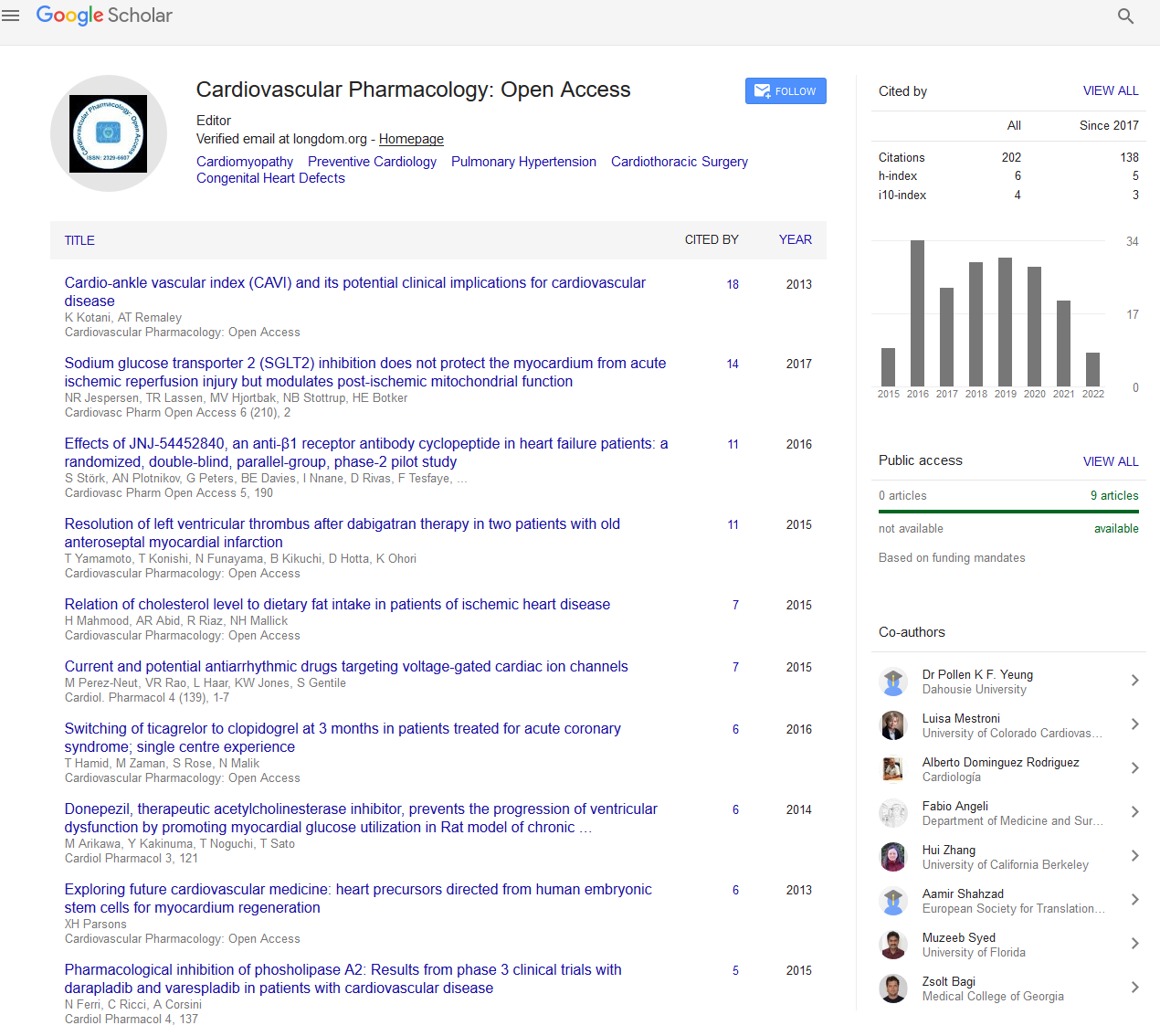Indexed In
- Open J Gate
- Cosmos IF
- RefSeek
- Hamdard University
- EBSCO A-Z
- OCLC- WorldCat
- Publons
- Geneva Foundation for Medical Education and Research
- Euro Pub
- Google Scholar
Useful Links
Share This Page
Journal Flyer

Open Access Journals
- Agri and Aquaculture
- Biochemistry
- Bioinformatics & Systems Biology
- Business & Management
- Chemistry
- Clinical Sciences
- Engineering
- Food & Nutrition
- General Science
- Genetics & Molecular Biology
- Immunology & Microbiology
- Medical Sciences
- Neuroscience & Psychology
- Nursing & Health Care
- Pharmaceutical Sciences
Perspective - (2023) Volume 12, Issue 3
Assessment of Cardiovascular Risk Factors, Screening, and Rehabilitation of Atherosclerosis
Guang Shen*Received: 02-May-2023, Manuscript No. CPO-23-21422; Editor assigned: 05-Jun-2023, Pre QC No. CPO-23-21422(PQ); Reviewed: 19-May-2023, QC No. CPO-23-21422; Revised: 26-May-2023, Manuscript No. CPO-23-21422(R); Published: 02-Jun-2023, DOI: 10.35248/2329-6607.23.12.350
Description
Cardiovascular diseases are paved over by atherosclerosis, a complicated and gradual disease that silently forms within arteries. Understanding this sneaky ailment will enable us to take proactive measures for both prevention and treatment, thereby protecting the health of cardiovascular system. An artery wall's ongoing chronic inflammation is the cause of atherosclerosis. The inner lining of blood arteries, the endothelium, first becomes dysfunctional. Endothelial cells are damaged by things like high blood pressure, smoking, and high cholesterol levels, which makes it possible for lipid growth. Then, monocytes invade the artery walls where they undergo a transformation into foam cells and start the development of fatty streaks. A fibrous covering that covers the fatty deposits over time gives rise to atherosclerotic plaques.
Atherosclerosis develops and progresses as a result of several risk factors. The main contributing variables are age, family history, high blood pressure, smoking, diabetes, obesity, and a sedentary lifestyle. The risk is also increased by high levels of LDL (lowdensity lipoprotein) cholesterol and low levels of HDL (highdensity lipoprotein) cholesterol. Millions of people worldwide are affected by atherosclerosis, which is a primary cause of mortality and disability. Atherosclerosis is a disease that becomes worse over time. The unstable atherosclerotic plaques may grow and change over time. This instability raises the risk of heart attacks and strokes as well as consequences such peripheral artery disease, carotid artery disease, and coronary artery disease. Blood clots can develop in response to plaque erosion or rupture, obstructing blood flow to essential organs. Atherosclerosis may be found and assessed using a variety of diagnostic techniques. Lipid profiles, one type of blood test, may measure cholesterol levels and spot anomalies. The artery walls and the degree of plaque development may be seen using imaging techniques including ultrasound, Computed Tomography (CT), and Magnetic Resonance Imaging (MRI). Information on the degree and location of blockages is provided in detail by invasive procedures like angiography. Prevention is crucial in the fight against atherosclerosis. Significantly lowering the risk of atherosclerosis and its problems involves making lifestyle changes, such as switching to a heart-healthy diet, getting regular exercise, stop smoking, controlling blood pressure and cholesterol levels, and keeping a healthy weight.
Medical interventions and treatment options, the main goals of medical atherosclerosis interventions are to control risk factors and avoid consequences. Statins and other cholesterol-lowering drugs are frequently recommended to lower LDL cholesterol levels. The cornerstones of treatment include antiplatelet therapy, blood pressure control, and lifestyle modifications. In extreme circumstances, it may be required to perform surgical treatments like Coronary Artery Bypass Grafting (CABG) or therapies like angioplasty and stenting.
All phases of atherosclerosis involve inflammation to some extent. The recruitment of immune cells, including macrophages and T cells, to the artery walls is sparked by the chronic inflammatory response. These cells discharge inflammatory mediators that aid in the formation and destabilisation of plaques. Targeted therapeutics with the dual goals of decreasing inflammation and preventing plaque development are made possible by understanding the complex link between inflammation and atherosclerosis. The vulnerability to atherosclerosis is also influenced by genetics. The chance of developing the condition is increased by certain genetic variations that affect lipid metabolism, inflammatory pathways, and endothelial function. For instance, a hereditary condition known as familial hypercholesterolemia causes raised LDL cholesterol levels as well as a much higher risk of atherosclerosis.
Arch enable better risk assessment and personalised treatment plans. Diabetes is a substantial risk factor for accelerated plaque development and unfavourable cardiovascular events. Diabetes and atherosclerosis frequently coexist. Diabetes-related metabolic problems such as insulin resistance, hyperglycaemia, and others cause endothelial dysfunction and inflammation, which accelerate the development of atherosclerosis. For those with diabetes, controlling blood sugar levels and improving diabetes management are crucial to lessening the effects of atherosclerosis.
Imaging methods for atherosclerosis are constantly improving and giving us important information on the vulnerability, composition, and load of the plaque. In-blood artery imaging techniques like Intravascular Ultrasonography (IVUS) and Optical Coherence Tomography (OCT) make it possible to see the arterial walls in great detail.
There are non-invasive ways to evaluate plaque activity and inflammation using modern imaging modalities including Positron Emission Tomography (PET) and magnetic resonance imaging. The risk classification, treatment planning, and intervention efficacy monitoring processes are all aided by these imaging technologies. Targeted medicines have promise in lowering plaque load and avoiding cardiovascular events, such as monoclonal antibodies that block pro-inflammatory molecules or improve cholesterol clearance.
CRISPR-Cas9 and other gene editing technologies provide possible ways to change the genetic elements that cause atherosclerosis. Approaches in regenerative medicine seek to encourage the repair of broken blood arteries, perhaps correcting atherosclerotic alterations.
Our focus must be on atherosclerosis, which is the root cause of many cardiovascular illnesses. By adopting a heart-healthy lifestyle and getting the right medical care, we can safeguard our cardiovascular health and liven up our lives.
Citation: Shen G (2023) Assessment of Cardiovascular Risk Factors, Screening, and Rehabilitation of Atherosclerosis. Cardiovasc Pharm. 12:350.
Copyright: © 2023 Shen G. This is an open-access article distributed under the terms of the Creative Commons Attribution License, which permits unrestricted use, distribution, and reproduction in any medium, provided the original author and source are credited.


